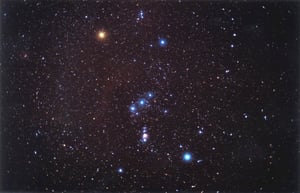 Once upon a time, in a valley tucked away in the Rockies, there was a place they called Min’urn. River in front…cliffs behind…good water, not much wind; a good place to live.
Once upon a time, in a valley tucked away in the Rockies, there was a place they called Min’urn. River in front…cliffs behind…good water, not much wind; a good place to live.
Here, in this quaint and crunchy valley, lived seven mountain-nymph sisters: Electra, Alcyone, Maia, Taygete, Asterope, Celaeno and Merope. Their father was Atlas, a Titan who brought home the bacon holding up the sky, and their mother was Pleione, the protectress of sailing.
One blustery Ladies Night at Magustos, the sisters were approached by a giant bearded man. Muscular, laden in camo print, and smelling a few days past expiration, he offered to buy them a drink. The sisters knew of him. His name was Orion, son of Poseidon, a man of great stature and an exceptionally talented huntsman. But - he came with a wild past of womanizing, jealously, brawls, and a whole lot of other baggage. The ladies politely turned down his offer. Orion, a few pitchers deep and ravenous with testosterone, pursued the sisters, adamant that they “drink a well on him” and give him their cell phone numbers. The ladies protested and conspired in the bathroom together to wait till he left. Orion was relentless. He was a hunter by nature, and he had fallen in love, or rather, he was in love with the challenge, the most dangerous game of chasing the ladies.
Meanwhile, the Gods watched from above, shaking their heads and tut-tutting. Zeus couldn’t take it any more; he had to step in and rescue the girls. A fan of animal transformations, Zeus turned the sisters into doves, where they flew far away from Orion’s reach, forever remaining in the sky.
And so the ladies were placed among the stars, and on the front of 90% of the cars in this valley. That’s right, in Japan the star cluster is called “Subaru”. Here, we call the Subaru stars the Pleiades, most likely derived from the Greek for doves, peleiades.
Orion’s lascivious behavior finally caught up to him. Stories vary, but Artemis, being goddess of the wilderness and the hunt, appreciated his pursuit for sport or game but did not approve of Orion’s endeavors. Be it jealousy, or Orion’s threats to kill every animal on the planet, Artemis finally killed him. Orion joined the sisters in the sky shortly thereafter, immortalizing the chase.
The sisters were not unprotected, though, as Taurus the bull guards the sisters who sit on his shoulder. The story is that Zeus transformed himself into a bull in order to seduce and abduct the Phoenician princess Europa. He was the finest bull in the herd and caught the princess’s eye with his strength and prowess. In commemoration, and to the seven sister’s relief, Zeus placed the bull in the heavens as a constellation.
From: Current Location To: Pleiades
To view these ancient heroes, gaze up on a clear night around nine o’clock. Look for Orion’s Belt, three bright stars in a row in the southern sky. Above his belt are two bright stars, which form his shoulders. The top left star with an orange-red tint is the red-supergiant Betelgeuse. Below his belt are two stars, his knees, which form a rectangle with his shoulders. Orion’s right knee, Rigel, is one of the brightest stars of the night.
Let Orion’s belt be your guide. Follow the short, diagonal, three-star belt to a bright red star directly above Orion named Aldebaran. This is the brightest star of the constellation Taurus, and the eye of the bull that glares down at Orion. The constellation Taurus is shaped like a V (or the bull’s head if you really stretch your imagination). Above and to the right of the V-shape is the shoulder of the bull, also known as the star cluster Pleiades. The fine reflective dust surrounding the star cluster gives it a bluish haze.
Stories that tell how constellations came to be are among the oldest of all. Aside from this ill-adapted version of Greek mythology, many different tales are associated with the Pleiades. Take advantage of the cold skies before late spring when Taurus will be lost in the sun’s glare. See how many of the sisters you can count with the naked eye, or come look through a scope with the Eagle Valley Astronomical Society the second Thursday of every month at Walking Mountains!
Author, Brittany Bobola, is a naturalist at Walking Mountains Science Center. She is a simple woman that enjoys breakfast food, good music, and playing outside. She would like to thank her roommate for inspiring her to write this story.









